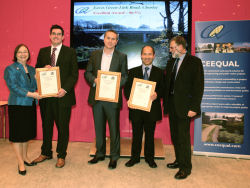Eaves Green Link Road, Chorley |
|
Whole Project Award
Project Team:
Client & Design: Lancashire
County Council
Construction: Birse
Civils
|
The project
Achieving environmental best practice was a central objective of the Eaves Green Link Road project, due to the site’s sensitive location alongside the River Yarrow and Duxbury Woods. A proactive approach to design and construction innovation ensured minimal environmental impact, reduced carbon emissions and the creation of new wildlife habitats.
Completed 15 weeks early and within budget, the Eaves Green Link Road is a 1.4-km single-carriageway road completing the southern and western bypass of Chorley. A new roundabout ties it in at the western end, with a new traffic-signal-controlled junction to the A6 at the eastern end. A 60-metre 3-span concrete bridge crosses the River Yarrow. Work started in December 2006 and the project was completed in November 2007.
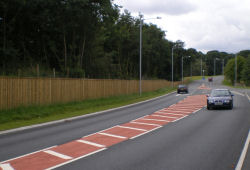 |
|
Securing long-term sustainability for Eaves Green
As a former manufacturing base, the local area around Eaves Green in Chorley forms a key strategic employment area for Lancashire County Council. The scheme was designed to facilitate the development of the area, and open up employment opportunities for the local community. The road has improved access to local facilities, in particular schools and employment, with newly established viable public transport routes in the area.
The new road has also relieved traffic and increased road safety on ‘rat-runs’, as well as creating a second access for residents and emergency services to the 800 houses in the Eaves Green neighbourhood.
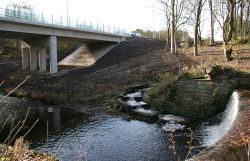 |
|
Environmental Impact Assessment
During the planning stages of the scheme, Chorley Borough Council conducted a comprehensive Environment Impact Assessment. This looked at the impact of the scheme on the local community, landscape, ecology and cultural heritage, with particular attention to noise, air quality and vibration. From this, Lancashire County Council developed strategies to prevent negative environmental impacts.
Habitat creation and biodiversity
Protecting local wildlife was a key consideration, not only during construction but also as a long-term objective. A Sustainable Drainage System (SuDS) successfully created new habitats for great crested newts, with a ‘hibernacula’ (shelter for hibernating animals) and adjoining tunnels under the road to allow the newts to cross safely. In addition, 78 bat boxes were installed around the site.
As the River Yarrow contains breeding sea trout, a 1-metre exclusion zone was created around the riverbank to prevent any contamination of the watercourse. In addition, the site team supported the Friends of the River Yarrow with the clearance of trees and debris from the salmon fish pass.
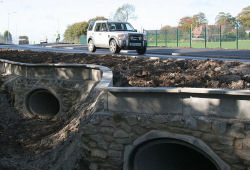 |
|
Recycling & innovation
With 84% of materials, by value, having recycled content, the scheme preserved natural resources, as well as minimising transportation to landfill. To further reduce off-site disposal, surplus materials were given to an adjacent housing contractor.
During construction, the site team attempted to boost the use of recycled materials by trialling recycled surfacing material. The supplier is using the results from the trial to develop the product for future use. By demonstrating a firm commitment to recycled materials and broadening their use, the team actively aided the development of sustainable construction.
Reducing carbon emissions
Innovative land remediation techniques successfully eliminated 24,000m³ of waste material and prevented the need to import additional fill. Re-using this site-won material prevented 12,000 wagon movements transporting material on and off site, resulting in a 98% reduction in carbon emissions.
The team ensured high levels of local employment to support the local economy and reduce car emissions. 81% of subcontractors were employed from the local area, and the team proactively measured the carbon emissions from staff travelling to and from site.
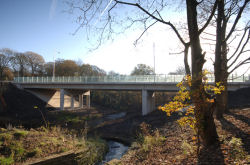 |
|
Reducing noise pollution
The new road was purposely designed in a cutting to minimise the impact of additional traffic noise. The team also used a low-noise ‘thin surfacing’ for the final layer of road construction to reduce tyre noise. Over 1,000 metres of timber screen fencing was installed in sensitive areas to further reduce noise pollution.
The use of a tinted-perspex environmental barrier on the bridge prevents noise disturbing the valley below. In addition, the bridge design reduces future maintenance costs and minimises disruption to road users.
Environmental accolades
The success of the Eaves Green scheme has been recognised by the Green Organisation, the Considerate Constructors Scheme (CCS) and the Institution for Highways and Transportation. In addition to the CEEQUAL Excellent, the project achieved:
- Green Apple Award for Environmental Best Practice
- CCS Silver Award with an overall score of 99% and an Environmental score of 100%
- North West Transportation Project of the Year
- Builder and Engineer Civil
Engineering Project of the Year


